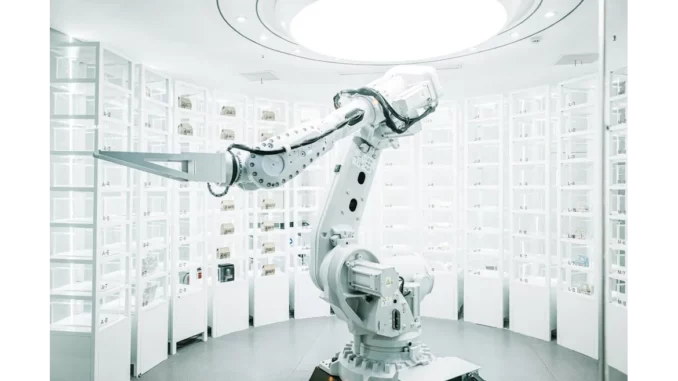
Summary
SK Hynix Unveils Groundbreaking Memory Technology at Seoul Summit
At the SK AI Summit in Seoul, SK Hynix CEO Kwak No-jung introduced a revolutionary memory technology, the HBM3E 16-layer memory. This innovation promises to redefine data storage and processing, marking a significant leap for the industry. Key discussions revolved around the role of memory semiconductors in the digital age and their potential to drive AI advancements, as articulated by senior engineer Emma Kim.
Main Article
Unveiling the Future of Memory Technology
The SK AI Summit, held at the bustling COEX in Seoul, became a focal point for the latest advancements in memory semiconductors—a field often overshadowed by more visible tech sectors yet crucial for digital innovation. The centrepiece of the event was CEO Kwak No-jung’s announcement of the HBM3E 16-layer memory, a development poised to transform data storage and processing capabilities across industries.
Emma Kim, a senior engineer at SK Hynix, provided an insider’s perspective on the presentation, highlighting the transformative potential of this technology. “It’s not just a breakthrough for SK Hynix but for the entire semiconductor industry,” Kim noted, underscoring the broad impact of this innovation.
Understanding the Role of Memory Semiconductors
During his address, CEO Kwak demystified the complex world of memory semiconductors, likening their role in data storage to historical media such as paper. “Memory is a key device for data storage,” Kwak elaborated, drawing parallels to how paper has preserved information across centuries. This analogy bridged the technical nature of semiconductors with their fundamental utility in modern life.
Emma Kim emphasised the integral role memory plays in everyday technology, from smartphones to cloud computing. “Kwak’s explanation was clear and straightforward,” she said, pointing out the distinct functions of DRAM and NAND in data movement and storage, respectively. These components are indispensable in the functioning of contemporary devices and systems.
Advancing in the AI Era
The summit also spotlighted the pivotal role of memory in the evolving AI landscape. CEO Kwak stressed the limitations of traditional semiconductors in meeting the demands of AI-based data processing. “Traditional semiconductors just don’t cut it anymore,” Kim confirmed, noting the necessity for memory that can rapidly and efficiently manage vast data volumes.
Kwak’s vision for ‘creative memory’ aligns with AI developments, advocating for memory semiconductors that not only store data but also facilitate advanced AI functions through learning and reasoning. “It’s about preserving the past to create new experiences for the future,” Kim echoed, reflecting the visionary aspect of Kwak’s message.
Benchmarking Technical Excellence
SK Hynix’s technical achievements were on prominent display, with CEO Kwak celebrating the development of the first-generation nanometre-class DDR5 DRAM and a staggering 321-layer NAND. “We’re setting benchmarks,” Kim stated proudly, asserting that the HBM3E is merely the beginning of a new era in memory technology.
The anticipated performance enhancements—an 18% boost in learning and a 32% increase in inference capabilities—are noteworthy. However, Kim pointed out that the true significance lies in the applications these advancements enable. “Faster processing, better AI capabilities, and more efficient data centres,” she elaborated, highlighting the broader implications for technology and industry.
Detailed Analysis
The unveiling of the HBM3E 16-layer memory represents a milestone in the semiconductor industry, underscoring SK Hynix’s position at the forefront of technological innovation. As data demands escalate, driven by AI and cloud computing, the need for advanced memory solutions becomes paramount. SK Hynix’s focus on high bandwidth memory (HBM) aligns with industry trends prioritising speed and efficiency in data processing.
CEO Kwak’s emphasis on ‘creative memory’ reflects a broader shift towards integrating memory functions with AI capabilities, enabling devices to not only store information but also contribute to intelligent processing. This approach is indicative of a trend where memory technology evolves from a passive storage role to an active component in AI systems.
The development of nanometre-class DRAM and multi-layer NAND places SK Hynix at the cutting edge, setting benchmarks that competitors may find challenging to meet. Such advancements highlight the company’s commitment to not only leading in innovation but also setting industry standards.
Further Development
Looking ahead, SK Hynix is gearing up for further technological advancements. CEO Kwak outlined plans for next-generation technologies such as LPCAMM2 and PCI Gen6 eSSD, aiming to secure the ‘World First’ title in the memory industry. “The goal is to stay ahead,” Kim noted, emphasising the importance of meeting customer needs through technological leadership.
Customisation emerges as a key strategy, with SK Hynix focusing on developing tailored solutions like custom HBM4E and HBM5 models in the coming years. “It’s about more than just innovation,” Kim explained, “it’s about providing solutions optimised for each client.”
As the memory semiconductor sector continues to evolve, stakeholders and industry watchers alike will be keenly observing SK Hynix’s next moves. The company’s ongoing commitment to innovation and customisation suggests a dynamic future, with further developments anticipated. Stay tuned for more in-depth coverage and analysis of how these advancements are shaping the digital landscape.

